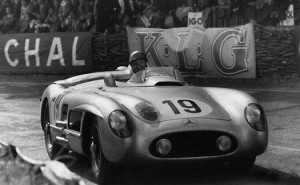Le Mans 1955: A Day of Tragedy 6

Five-time F1 Champion Juan Manuel Fangio was able to narrowly avoid disaster during the horrible accident at the 1955 24 Hours of Le Mans.
The element of danger in sports is like a wedding ring: always present, a constant reminder of commitment, passion…and eternity. All too often that tantalizing element has come calling, then taking the heroes we thought were invincible. On rare, regrettable occasions, danger spreads its cloak beyond the field of play to encompass even the spectator. This is an account of one such tragedy.
The Course
June 11, the 1955 24 Hours of Le Mans at the famous 8.38 mile track outside the French town of Le Mans. Traffic moves in a clockwise direction with the pits and infield being on the driver’s right and the grandstand and spectators on the left.
The Principals
Mercedes, Jaguar, Ferrari, Aston Martin and Maserati were the fierce competitors of the era. Daimler-Benz (Mercedes) had three of their new ultra-light 300SLR cars in the race. The formidable team of five-time F1 World Champion Juan Manuel Fangio and the legendary Stirling Moss were favored to win it for Mercedes. Another Benz car featured the team of Frenchman Pierre Levegh and the American, John Finch.
Jaguar was up to the challenge with the team of Mike Hawthorn and Ivor Bueb in their D-type.
Lance Macklin, driving an Austin-Healey 100, was the man “caught in the middle” when all hell broke loose. Read the rest of this entry →